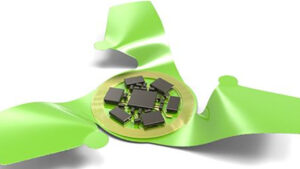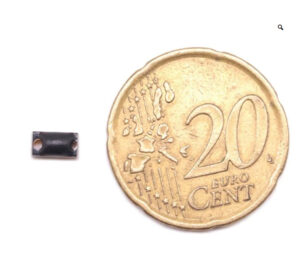إن مركبات الهواء الصغيرة المدعومة من جهاز NFC هي طاقم عمل رائع. يعمل الباحثون على المرحلة التالية من مشروع مدته ثلاث سنوات لإنشاء جهاز صغير. That can fly. collect sensor readings in the ambient air and transmit the results through near-field communication (NFC). NFC tag is a kind of علامة RFID. The NFC device has special wings and design to fall from the aircraft and take off.
The Team
Published their first peer-reviewed paper on the subject in the journal Nature in September 2021. More work is in progress and will describe in a follow-up paper this summer. The entire sensor device equip with fins, NFC software on chip (SOC) and sensor technology. The size is only a few millimetres. You can choose to use other wireless technologies to reduce it to the size of sand. When the tag release into the airflow. Its 3D wing allows it to drift with the airflow in a combination of rotation and gliding motion.
NFC micro air vehicle
The team’s goal is to design a battery free technology that can disperse in the environment to capture environmental sensor information. Such as pollutants and weather patterns, when gliding to earth. NFC technology can use to capture accumulated sensor data after the tag is landed. John Rogers, Professor of Bio-electronics at Northwestern University. And co-author of the white paper, said that one of the unique features of the device is that. It uses a set of sensor technology to monitor the physiological parameters of the human body.

NFC Device
Over the past
Decade or more, researchers at the University have been building and testing such biosensors. Including small body adaptation devices or implants to meet the needs of patients, or basic biological research on humans or animals. “We have a range of NFC devices,” Rogers said, which can transmit and forward sensor data at 13.56 MHz in accordance with ISO 14443. The tag not only responds to the transmission from the reader. Such as the one built into most smartphones, but also transmits its own unique ID number and collected sensor data.
Tracking
When tracking physical conditions, labels and sensors can be implanted directly into the human body or attached to the skin. “In these cases, you don’t have to worry about dispersion – you just put them where you need them,” Rogers said. “The goal of our recent work is to raise the question. ‘ Is there a way to use the basis of technology and body integrated equipment to monitor health rather than environmental processes?'” he recalled the development of micro air vehicles.
John Rogers
According to Rogers, labels for environmental monitoring need to be distributed on a large scale. “So that’s the question,” هو قال. “We tried to answer: ‘what’s the mechanism of diffusion?’ which led to the study of the aerodynamics of passive flight. Researchers turned to nature for help. To some extent, they simulate their research. The wings of maple seeds fell off the tree and let the wind carry them away from the branches. In addition to simply applying one wing.They also used three wings to guide passive flight in a helicopter configuration with three-dimensional shape.
Integrated Circuit
The center of the device is an integrated circuit. When the micro air vehicle falls in the air, its wings interact with the water flow to produce slow and stable rotational motion. The weight of the electronic equipment distribute in the center of the micro aircraft to prevent it from losing control. And tumbling in a chaotic way. There is no battery, but the built-in power supply of the chip can collect environmental energy from sunlight and store the collected sensor data.

Mini tag
Photodiode
The photodiode generates a photocurrent whose magnitude is related to the exposure intensity. The current charges the device in such a way that the accumulated charge can define the voltage on the supercapacitor on the chip. Which indicates the exposure dose, thus indicating the size and concentration of particulate matter in the air. Rogers said that when the tag was asked, its response produced a set of cumulative voltages. Each corresponding to a dose of different wavelengths. “So indirectly,” هو قال, “it tells you the density and size of particles in the environment through spectral information.”
Once the sensor lands
It waits for data transmission. Rogers said one way to collect data is to use low flying UAVs equipped with NFC readers. As the tag falls, the drone can scan an area to read the tag data, and then upload it to the server. “Conceptually,” هو شرح, “you’re folding the amount of 3D data (captured when the label passes through the atmosphere) onto a 2D surface, and then you can scan it.”
إلى هذا الحد, the test carried out in the NFC environment, not in the field. To test the device’s ability to capture particle data, the team used a dust generation chamber with incense sticks, smoke candles and corn starch. A series of four fans placed at the bottom of the chamber generate air flow, through which the micro air vehicle can slide.
The next stage
The next stage of development may involve outdoor testing of the equipment and further Wing Engineering. “We are studying different types of wing structures,” Rogers said. “Inspiration comes from different types of seeds.” He pointed out that there are more than one way to fly in nature. فمثلا, while early research focused on helicopter motion during free fall, “you can imagine dandelions, parachute structures, and other types of gliders,” these are other potential ways to disperse sensors to the ground
Not the Only NFC
NFC is not the only way to capture data from a device. The team also explored the discoloration chemicals that can see by the cameras installed on the UAV. فمثلا, yellow may indicate the detection of pollutants in the upper atmosphere. “Some of our work also focused on developing these colorimetric methods,” Rogers said. “We are looking for a variety of methods, each of which is suitable for different applications and has more possibilities for combination.” He added: “I think that in the end, digital wireless will be the only way to go.” specific data can collect through NFC technology, including the unique ID of the sensor and the accurate sensor results transmitted.
A biodegradable version
Of the technology may emerge, building on the team’s work in temporary implants based on bioabsorbable electronic devices. “We have a whole set of materials that can support complex forms of electronic products,” Rogers said. “But as a unique defining feature, it has the ability to dissolve in water.” In this work, the researchers worked with a commercial silicon foundry to build biodegradable silicon integrated circuits, which can support NFC functions in principle.
قدرات
Rogers speculates that these devices can monitor various conditions. Including weather patterns, chemical spills and the spread of pathogens or infectious diseases. في نفس الوقت, the team is continuing to study air flow. Which may be induced when the label passes through the upper atmosphere. Looking ahead, researchers hope to establish contacts with technology companies to complete the next step of development.





